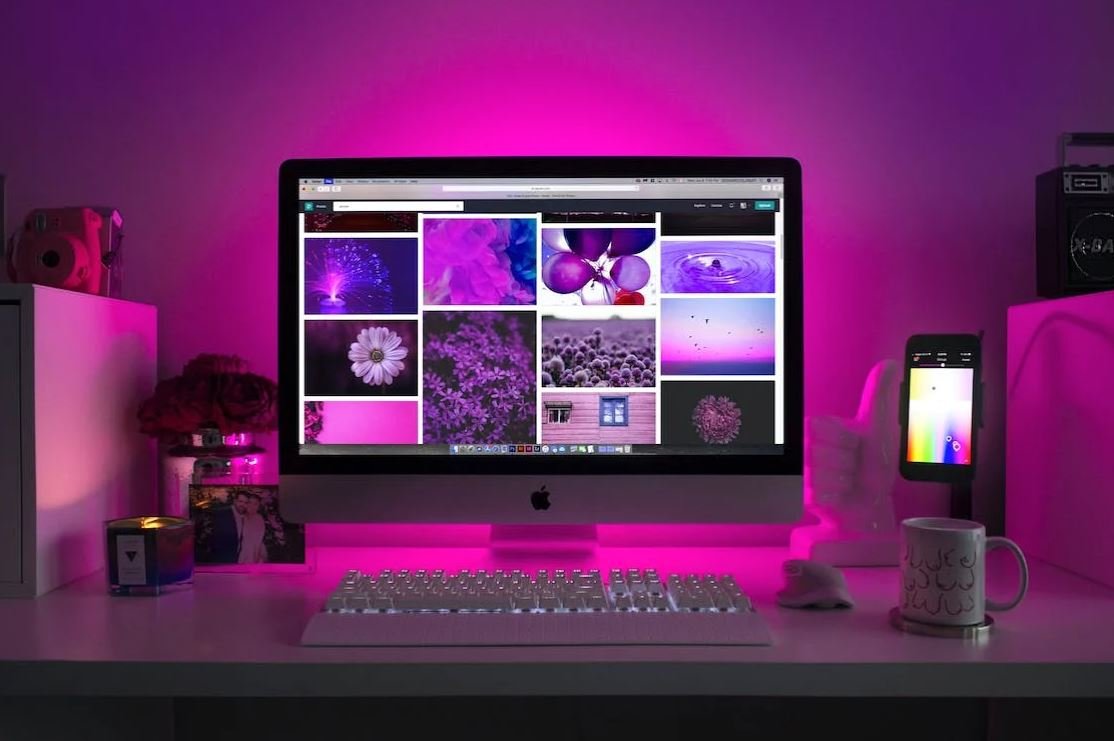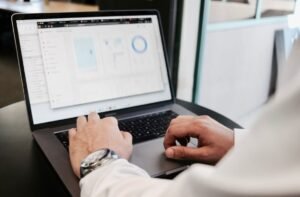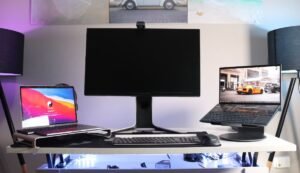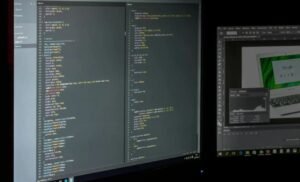Generative Art vs AI Art
Generative art and AI art are two fascinating disciplines that intersect the worlds of technology, creativity, and visual aesthetics. While both involve the use of algorithms and computer-generated processes, they have distinct characteristics that set them apart. Understanding the differences between generative art and AI art is key to appreciating the unique creative possibilities they offer.
Key Takeaways:
- Generative art and AI art both utilize algorithms and computer-generated processes.
- Generative art focuses on creating artwork through rule-based systems and randomization.
- AI art involves using machine learning algorithms to generate or manipulate artwork based on training data.
- Generative art offers a sense of unpredictability and exploration, while AI art aims to replicate human creativity.
Generative Art
Generative art is a field of artistic practice that relies on predefined rules and mathematical models to produce artwork. Artists design algorithms that determine the way visual elements, such as shapes, colors, and patterns, are generated. *This allows for an infinite variety of outputs, as each iteration results in a unique artwork.*
Generative art often involves the exploration of emergent properties, where complex and visually intriguing patterns emerge from simple rules. Artists can create dynamic systems that evolve and change over time, resulting in artwork that is constantly evolving. Additionally, generative art can leverage randomness to introduce an element of chance into the creative process, leading to unexpected and surprising results.
AI Art
AI art, on the other hand, relies on machine learning algorithms to generate or manipulate artwork. Machine learning models are trained on vast amounts of data, such as existing artwork or photographs, to learn patterns and create new visual outputs. *This allows AI systems to emulate artistic styles and techniques based on the learned information.*
AI art can involve various techniques, including style transfer, where a model transfers the style of one artwork onto another, or image generation, where AI systems generate entirely new images from scratch. The aim of AI art is to mimic human creativity and produce artwork that is indistinguishable from those created by humans. However, AI art is limited by the data it is trained on and lacks the depth of subjective human experience and consciousness.
Comparison
| Aspect | Generative Art | AI Art |
|---|---|---|
| Algorithm Complexity | Artists design rules and mathematical models to generate artwork. | Machine learning algorithms process and generate artwork based on training data. |
| Creativity | Offers a high degree of unpredictability and openness to exploration. | Aims to replicate human artistic styles and techniques. |
| Data Dependency | Relies on pre-defined rules and randomness, not heavily dependent on external data. | Requires extensive training data to generate or manipulate artwork. |
Applications and Impact
- Generative art finds applications in fields like visual design, interactive installations, and computational aesthetics.
- AI art has been used for style transfer filters in photo editing applications and has raised questions regarding authorship and the role of AI in the creative process.
- Both disciplines push the boundaries of creativity and challenge traditional notions of art production and authorship.
Conclusion
Generative art and AI art share a common foundation built on algorithms and computer-generated processes, but they diverge in their approach to creativity and the use of training data. While generative art embraces randomness and allows for endless exploration, AI art aims to replicate human artistic expression. The interplay between generative and AI art opens new doors for artistic experimentation and challenges our understanding of what truly constitutes art in the digital age.

Common Misconceptions
Misconception 1: Generative Art and AI Art are the Same Thing
One common misconception is that generative art and AI art are interchangeable terms. While both involve the use of algorithms and computational methods to create art, they are not the same. Generative art refers to the creation of art through the use of programmed systems or rules, where the artist’s input and control play a significant role. AI art, on the other hand, specifically involves the use of artificial intelligence algorithms and machine learning techniques to create artwork.
- Generative art allows artists to have more control over the creative process.
- AI art relies on the ability of the algorithm to learn and generate art without explicit instructions from the artist.
- Generative art focuses on the system or process used, while AI art highlights the use of AI technology in the creation of artwork.
Misconception 2: AI Art Eliminates the Need for Human Artists
Another misconception is that AI art will replace human artists in the future. While AI technology has made significant advancements in generating artwork, it cannot completely replace human creativity and artistic vision. AI algorithms are only as good as the data they are trained on, and they lack the ability to convey emotions or possess subjective experiences. Human artists bring unique perspectives, emotions, and creativity to their work, which AI cannot replicate.
- AI algorithms lack intuition and cannot possess original ideas.
- Human artists bring their personal experiences and emotions into their artwork.
- AI art can be seen as a tool that complements and enhances human artistic abilities rather than replacing them entirely.
Misconception 3: Generative Art and AI Art are Easy to Create
There is a misconception that generative art and AI art are relatively easy to create because they involve the use of algorithms or AI systems. However, creating meaningful and impactful art using these technologies requires both artistic skills and technical expertise. Artists need to have a deep understanding of the underlying algorithms, computational methods, and artistic principles to create compelling generative or AI-generated artworks.
- Creating generative or AI art requires a strong foundation in both art and computer science.
- Artists need to experiment and iterate to refine their generative or AI art creations.
- The technical complexity involved in generating or training AI algorithms can be challenging for artists without expertise in machine learning.
Misconception 4: Generative Art and AI Art Lack Artistic Authenticity
Some people believe that generative art and AI art lack authenticity and are simply the result of machines following predefined rules or algorithms. However, just like any other art form, the authenticity of generative or AI art comes from the artist’s creative intent and artistic decisions. Artists using these technologies still make choices, set constraints, and bring their unique perspectives to their artwork.
- Generative artists make conscious decisions about the rules and parameters that govern the creation process.
- AI algorithms are trained using specific datasets and parameters chosen by the artist, influencing the resulting artwork.
- Generative and AI artists can inject their personal touch and artistic style into their creations.
Misconception 5: Generative Art and AI Art Lack Originality
Another misconception is that generative art and AI art lack originality because they are created using preexisting algorithms or trained on existing datasets. However, generative art allows artists to explore new possibilities and create unique artworks by defining and modifying the underlying rules and systems. AI art, although trained on existing data, can generate unexpected and novel creations that go beyond what has been seen before.
- Artists can push the boundaries of existing generative algorithms to create new, unique art forms.
- AI art can produce surprising and innovative results by the algorithm’s ability to learn patterns and generate novel outputs.
- Generative and AI artists can introduce randomness and unpredictability into their creative processes to achieve original artwork.

Generative Art vs AI Art
Generative Art and AI Art are two emerging branches of artistic expression that use technology to create unique and innovative works. While both rely on algorithms and data, they differ in their methodology and the level of human involvement. This article explores the similarities and differences between Generative Art and AI Art through ten captivating tables.
Artistic Process
The table below explores the artistic process behind Generative Art and AI Art.
| Aspect | Generative Art | AI Art |
|---|---|---|
| Human Involvement | Direct input in designing algorithms | Human input through training data |
| Algorithm Complexity | Can be simple or intricate | Can handle complex patterns and data |
| Artistic Intention | Often explores randomness and unpredictability | Attempts to mimic human artistic style |
Influence of Technology
The following table delves into the influence of technology on Generative Art and AI Art.
| Aspect | Generative Art | AI Art |
|---|---|---|
| Tool Selection | Utilizes custom-built algorithms and software | Makes use of machine learning frameworks |
| Data Source | May generate output from scratch | Requires training data from existing artworks |
| Processing Power | Relatively lower computational requirements | Demands significant computational resources |
Artistic Techniques
The subsequent table illustrates the different artistic techniques employed in Generative Art and AI Art.
| Aspect | Generative Art | AI Art |
|---|---|---|
| Rule-based Systems | Uses predefined rules for artistic generation | Rule-based systems supplemented with machine learning |
| Procedural Generation | Generates artwork through mathematical procedures | Combines procedural generation with machine learning techniques |
| Data Manipulation | Relies on internal algorithms for data manipulation | Employs deep learning algorithms on training data |
Artistic Expression
The table below highlights the differences in artistic expression between Generative Art and AI Art.
| Aspect | Generative Art | AI Art |
|---|---|---|
| Originality | Produces original artworks with limited human influence | Often imitates existing artistic styles and themes |
| Uniqueness | Each output is distinct and unpredictable | Outputs may lack uniqueness due to reliance on existing data |
| Experimental Nature | Encourages exploration and experimentation | Strives for perfection and replication of human artworks |
Artistic Impact
The following table showcases the impact of Generative Art and AI Art in the art world.
| Aspect | Generative Art | AI Art |
|---|---|---|
| Artistic Collaboration | Collaboration between artists and algorithms | Artists collaborate with algorithms and machine learning models |
| Art Market | Gaining recognition as a unique and valued art form | Developing a market presence with increasing collector interest |
| Artistic Innovation | Pushes boundaries of traditional artistic practices | Explores new possibilities in creating art |
Ethical Considerations
The next table focuses on the ethical considerations surrounding Generative Art and AI Art.
| Aspect | Generative Art | AI Art |
|---|---|---|
| Authorship | Raises questions of authorship and the role of the artist | Raises concerns regarding the originality of AI-generated artworks |
| Ownership | Ownership rights challenging due to algorithmic generation | Ownership rights blur as AI models contribute to artistic creation |
| Algorithm Bias | Potential for bias lies in the hand of algorithm designers | The training data used may introduce biases into output artworks |
Audience Reception
The subsequent table explores the reception of Generative Art and AI Art among audiences.
| Aspect | Generative Art | AI Art |
|---|---|---|
| Engagement | Draws audience attention through its unique and unpredictable nature | Engages audiences with the blend of human and machine creativity |
| Artistic Access | Accessible to a broader range of artists due to algorithmic assistance | Requires access to machine learning technologies and expertise |
| Artistic Appreciation | Ignites discussions about the role of creativity in artistic production | Challenges traditional notions of artistic authorship and authenticity |
Artistic Legacy
The table below reveals the potential legacy of Generative Art and AI Art in the art world.
| Aspect | Generative Art | AI Art |
|---|---|---|
| Art Movements | Emerging as a new and distinct art movement | Contributing to the evolution of contemporary art movements |
| Artistic Traditions | Challenges traditional artistic practices and concepts | Expands on existing artistic traditions through technological integration |
| Critical Discussions | Fosters discussions about the nature of creativity and automation | Raises debates on the relationship between technology and human expression |
Conclusion
Generative Art and AI Art are two fascinating intersections of technology and artistic expression. While Generative Art embraces randomness and uniqueness, AI Art seeks to replicate and imitate. Both fields contribute to the dynamic landscape of contemporary art, pushing boundaries, and challenging traditional notions of authorship and creativity. As technology continues to advance, it is exciting to speculate on how Generative Art and AI Art will shape the future of artistic expression and contribute to the ongoing dialogue surrounding the impact of technology in society.
Generative Art vs AI Art – Frequently Asked Questions
Question 1: What is generative art?
Generative art refers to artwork created using a set of defined rules or algorithms that determine its creation process. The artist sets the rules, and the artwork is generated autonomously based on those rules.
Question 2: What is AI art?
AI art, on the other hand, involves using artificial intelligence algorithms to generate or manipulate artistic content. It involves training an AI model using machine learning techniques to recognize patterns and generate art with little or no human intervention.
Question 3: What is the main difference between generative art and AI art?
The main difference lies in the role of the artist. In generative art, the artist creates the rules and lets the artwork evolve on its own, whereas in AI art, the artist trains an AI model to create or manipulate artistic content based on learned patterns.
Question 4: Can generative art and AI art be considered the same?
While both generative art and AI art involve autonomous creation or manipulation, they have different approaches and philosophies. Generative art focuses on rule-based systems, while AI art relies on machine learning algorithms to create or manipulate art.
Question 5: What are some examples of generative art?
Examples of generative art include artworks created using fractal patterns, cellular automata, genetic algorithms, or other computational techniques that follow predefined rules to generate unique artwork.
Question 6: What are some examples of AI art?
AI art examples include using deep learning algorithms to generate images, applying style transfer techniques to transform images, or training AI models to create music or poetry based on existing works.
Question 7: Can generative art and AI art be combined?
Absolutely! Artists often utilize both generative techniques and AI algorithms in their creative process. They can use generative algorithms to generate initial designs and then use AI algorithms to refine or manipulate those designs further.
Question 8: What are the benefits of generative art?
Generative art enables artists to explore systems and rules in a creative context. It encourages experimentation and can lead to unexpected and unique artistic outputs that may not be achievable through traditional methods alone.
Question 9: What are the benefits of AI art?
AI art opens up new creative possibilities by leveraging machine learning techniques. It allows artists to work collaboratively with AI models, automate time-consuming tasks, and generate complex and intricate artworks that would be challenging to create manually.
Question 10: Is generative art and AI art considered a form of automation?
Generative art and AI art can be seen as forms of automation in the artistic domain. While they introduce automated aspects, they also involve human creativity and intervention in the initial setup, decision-making, or fine-tuning process of the artwork.




